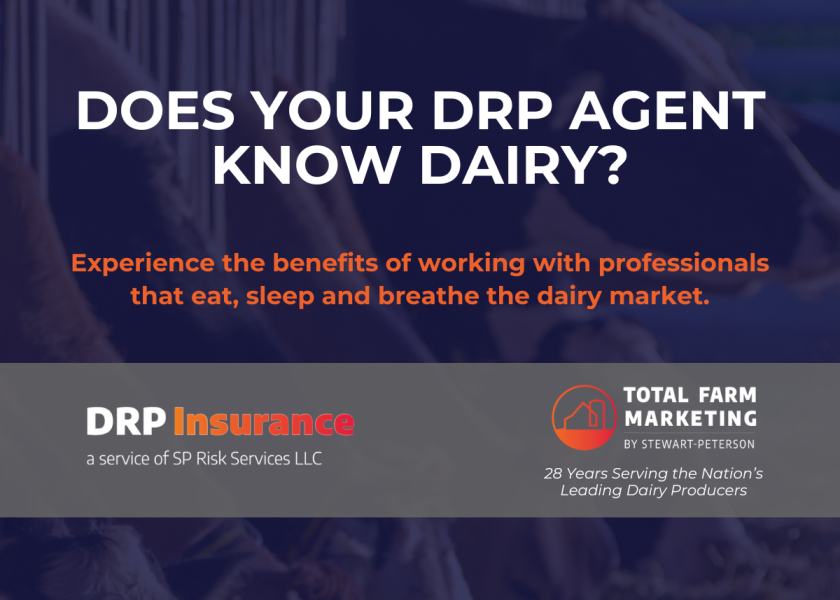Navigating Dairy Revenue Protection: Essential Considerations When Choosing Your DRP Insurance Agent

2023 was a challenging year for dairy producers, navigating economic struggles and uncertainties. In the tumultuous world of dairy farming, Dairy Revenue Protection (DRP) insurance emerges as a vital lifeline, helping to safeguard your farm against financial risks. Amidst the challenges of navigating these uncertainties, selecting the right insurance agent becomes a critical decision in ensuring the effectiveness of your DRP coverage. Let's explore the key questions to guide you through this important decision-making process:
Industry Experience and Focus:
When it comes to safeguarding your farm's revenue, experience matters. Would you call an appliance technician to fix your tractor? Of course not. Then why rely on a bank or crop insurance agent for something as influential to your farm’s profitability as DRP insurance? Seek an agent with a specific focus on dairy markets. Look for someone who understands the unique challenges and opportunities within the dairy sector, having weathered economic fluctuations and demonstrating a nuanced understanding of dairy revenue protection intricacies. Seek an agent who has worked with dairy farms in your region for years, helping them navigate through region-specific and herd-specific challenges. They understand the impact of factors like milk prices, feed costs, and government policies on your farm's profitability, enabling them to provide tailored advice and solutions.
Transparent Coverage Targets and Proactive Strategy Development:
Prioritize agents who act as proactive advisors, providing tailored insights and strategic recommendations to address your farm's specific needs. Valuable advice on risk management strategies and market trends adds significantly to your partnership with an insurance agent. Your agent should set coverage targets and provide transparent explanations behind these decisions, fostering trust and enabling alignment of your revenue protection strategy with your farm's financial objectives. As a true partner in your success, they recommend specific coverage levels based on sound research and your farm's unique cost structure.
Strategic Timing for DRP Endorsements:
Timing plays a crucial role in maximizing the benefits of dairy revenue protection. A knowledgeable agent should assist you in strategically placing DRP endorsements, considering both cost implications and potential indemnity benefits. Their ability to adapt and adjust your coverage strategy in response to evolving market dynamics is key to optimizing your farm's resilience. They constantly monitor the milk markets and are ready to advise you on when to purchase DRP endorsements. This is beneficial during periods of favorable market conditions when premiums are lower and potential indemnity payouts are higher, allowing you to maximize your coverage while minimizing costs.
Educate and Empower You with a Deeper Understanding of DRP
The best agents will educate you on the fundamentals of DRP insurance. They’ll take the time to ensure you understand how DRP works, coverage options, and eligibility, while demystifying insurance jargon and speaking in terms that are at your experience level. They’ll keep you updated on industry trends and policy changes, serving as your trusted resource for adapting your coverage strategy. They’ll take the time to answer important questions, such as:
- What are the differences between component and class pricing? More importantly, which should you choose?
- As a beginning or veteran farmer/rancher, are you eligible for any additional subsidies?
- What milk grades are insurable?
- How is actual milk revenue calculated for component pricing?
- Does your policy cover any other types of loss such as death of dairy cattle?
In conclusion, selecting the right DRP insurance agent gives you a strategic advantage in securing your financial stability. By forging a partnership with a knowledgeable and proactive agent — one who is equally committed to protecting your revenue AND expanding your DRP knowledge — you not only mitigate risks; you also unlock opportunities to thrive amidst uncertainties in the dynamic dairy landscape.
***
Total Farm Marketing has been helping dairy producers manage their risk for nearly 30 years. At SP Risk Services, a division of Total Farm Marketing, our team of experienced agents will work with you consultatively to develop a successful DRP strategy while providing clear explanations of coverage targets and empowering you to make informed choices. Our team leverages advanced quantitative analysis, extensive statistical research, and the latest in artificial intelligence and programming technology to help you maximize your protection while optimizing your milk prices.
Our results speak volumes. Over the last four quarters (CY2023), our DRP recommendations, if followed entirely, would have yielded an average net indemnity of $1.37 per CWT across 100% of production. What would a $1.37 positive net indemnity average mean to you?
Contact us online today or call (855) 334-0200 to learn just how much revenue you could be leaving on the table with your current DRP agent. Take our quick and simple DRP Risk Management Scorecard to get an instant, customized rating of your current DRP agent and strategy. Your premium cost will be the same, regardless of the agency you use. See how your current DRP insurance coverage stacks up.
***
SP Risk Services LLC is an insurance agency and an equal opportunity provider, may receive compensation from insurance companies for such sales, is not licensed in all states, and is part of the Total Farm Marketing family of companies. Issuance of insurance coverage is subject to underwriting review and approval. Policy obligations are the sole responsibility of the issuing insurance company. Any claims made pursuant to any policy are adjusted by the issuing insurance company. Past performance is not indicative of future results. The performance shown in the hypothetical results can vary significantly (positively or negatively) if a different time period is utilized. A positive indemnity is not guaranteed over any time period. The illustration above reflects net indemnity in Wisconsin. Net indemnities reflect total indemnity minus premium cost and is weighted per cwt across 100% of the milk for each quarter. Net indemnities will vary due to differences in premium costs, yield adjustment factors, and differences in Class III/Class IV milk utilizations.







